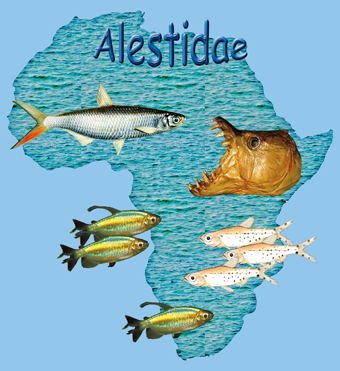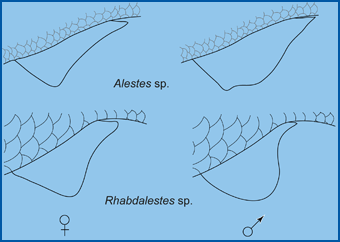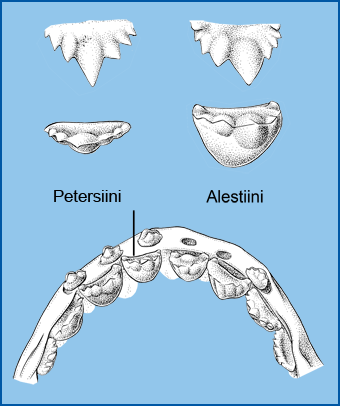Alestidae

Alestidae (formerly classified as Alestinae within Characidae sensu Greenwood et al., 1966) comprises currently 119 species of small to moderate-sized characiform fishes that are widely distributed throughout much of sub-Saharan tropical Africa. Members of the family span a broad range of sizes, shapes, and ecologies and range from the large (up to 1 m, 50 kg) predaceous Giant Tigerfish (Hydrocynus goliath) to the dwarf, largely entomophagous members of the tribe Petersiini (African ‘tetras’, typically smaller than 90 mm SL). Alestidae includes all African characiform fishes except for the families Distichodontidae, Citharinidae, and Hepsetidae and is generally regarded as monophyletic, diagnosed by a robust set of morphological synapomorphies summarized in Zanata & Vari (2005). The results from recent morphological (Vari, 1979; Buckup, 1998; Zanata & Vari, 2005) and molecular (Orti & Meyer, 1997; Hubert et al., 2005; Calcagnotto et al., 2005) studies serve as corroborative evidence that the group is monophyletic and warrants separate family status. Systematic studies on alestids have lagged behind that of their Neotropical counterparts, perhaps owing in part to the relatively fewer number of specialists working on African fishes and relative scarcity of available collections. The broader questions of the relationships of Alestidae among characiform fishes and the relationships among genera within the family remain largely unstudied to date and represent major unresolved issues that, considered together, cast doubt upon the traditional classification of the Alestidae (Brewster, 1986; Orti & Meyer, 1987; Buckup, 1998). However, several studies (Murray & Stewart, 2002; Calcagnotto et al., 2005; Zanata & Vari, 2005) are beginning to tackle these problems. Nevertheless, at present, comprehensive morphological evidence is unavailable for purposes of establishing unambiguous diagnoses of subfamilial groups and for the vast majority of the included genera.
Traditional classifications of the Alestidae (Roberts, 1969; Géry, 1977) recognise two subfamilies: Hydrocyninae (includes the sole genus Hydrocynus) and Alestinae (includes all other Alestidae). It is clear, however, that this subfamilial classification within Alestidae is inadequate, according to the results of Vari (1979) and Brewster (1986) who found Hydrocynus to be more closely related to a subset of Alestes species and Calcagnotto et al. (2005) who found, on the basis of molecular evidence, Hydrocynus to be more closely related to a subset of taxa traditionally placed within the Petersiini and therefore nested within the Alestinae. Both Calcagnotto et al. (2005) and Zanata & Vari (2005) found Arnoldichthys, traditionally placed within the Alestinae, to represent the basal sistergroup to all other Alestidae. We therefore reject subfamilial status for the Hydrocyninae but otherwise maintain the traditional tribal arrangement of genera as a matter of practical convenience. Finally, Zanata & Vari (2005) advocated inclusion of the Neotropical Chalceus in the Alestidae, whereas Calcagnotto et al. (2005) found Chalceus to be nested within a clade of strictly Neotropical taxa. Herein, we take a conservative approach that excludes Chalceus from the Alestidae. Three principal groups may be recognised within the family that are differentiated largely on the basis of the morphology of the teeth: Hydrocyini (with the alone genus Hydrocynus and five species; see below) characterized by strong, caniniform, mostly conical teeth, the Alestiini [sensu stricto, 47 species among Alestes (6 species), Brycinus (36 species), and Bryconaethiops (5 species)] characterized by more modest, pluricuspid teeth of which the inner row of premaxillary teeth is molariform, and the Petersiini (14 genera, 67 species) characterized by their smaller size and reduced pluricuspid teeth, where the second row of premaxillary teeth is typically not molariform. Except for Hydrocynus and Brycinus species of the ‘macrolepidotus’ group, most alestids exhibit pronounced sexual dimorphism for several features, notably a convex anal-fin margin, with anterior-most branched rays more or less sigmoid in shape (see figure below) and intense colouration in mature males.
Currently 18 genera and 119 species are assigned to the family Alestidae:
Alestiini (3 genera, 47 species)
Hydrocyini (1 genus, 5 species)
Petersiini (14 genera, 67 species)

Alestidae: sexual dimorphism in anal fin shape and configuration of anterior branched rays.
Bibliography
Key to tribes
1 All teeth caniniform arranged in a single row on both jaw; lateral line complete.................................Hydrocyini (=Hydrocynus)
Teeth multicuspidate, rarely conical, arranged in one or more rows on the upper jaw..............................................................2
2 Teeth arranged in one or more rows on the upper jaw, the inner row comprised of molariform teeth (see figure below).....Alestiini
Teeth arranged in to rows on the upper jaw, the inner row of teeth not molariform (see figure below)............................Petersiini

Alestidae: arrangement and shape of the teeth.





